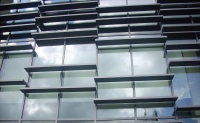More light
Ways to get more light into a room or corridor
Decor
White paint is as reflective as paint gets. Paints sold as 'reflective' actually reflect less light, and are more about reflecting as much of the light as possible back in the direction it came from.
White floor tiles help of course, or lighter carpet colours.
Windows that are recessed, as most are by a few inches, sometimes have the exterior edge of the brickwork painted white. This adds a small amount of light, but the appearance isn't always liked, and once painted it can't practically be removed.
Electric light
Concealed uplighting can transform light levels. See Fluorescent Lighting, CFL and Uplighters.
A fake window is fairly easy to make, there are a few ways to do it. One is just 2 vertical fluorescent lights behind a curtain, one light near each edge of the curtain. Protection against breakage can be added with metal mesh or a clear plastic tube if needed. With the curtain kept closed, almost everyone thought it was a real window, even after months of regular visits.
Its possible to mimic sunlight with a halogen lamp. For example where there is a front door plus an interior framed glass divider, a 150w halogen lamp can be fitted to the ceiling between front door and inner door, where it shines down through the inner windows creating somewhat sunlight-like shadows.
Sometimes a more powerful bulb is all that's needed. CFLs can put out a lot more light in an open holder than filament due to power limitations & efficacy (if a powerful enough lamp is used), and CFLs of more than 23w are available from various online sellers.
Mirrors
One approach is to change the direction of the incoming daylight from downward to upward. That way it hits a white ceiling rather than a darker floor. You can do this and add more light with a nearly horizontal mirror. Little 6" deep ones can be made to look ok. If it goes on the outside it adds more incoming light, if it goes inside it changes the direction of some already incoming light. Exterior mirrors sit on the cill, interior ones can either be at the same level or part way up the window.
A big 15" deep mirror on the exterior window cill can double interior light level, but usually appearance rules these out. These can be useful on outbuildings, and can double as shutters. See Solar Mirrors for details.
Windows in thick walls (eg rubble filled stone walls) can have the interior wall edges mirror lined.
Light tubes are reflective tubes that bring light into areas with no outside wall. The interior fitting looks like an ordinary electric light. They collect light from a dome mounted on the roof.
Paving
Its also possible to use reflective paving outside, eg stainless steel, which can reflect some skylight onto the ceiling.
White stone chips on the ground outside also provide a bit of extra incoming light, and are cheap & simple.
Glazing
Doors can be replaced with a part or fully glazed door. Oak doors & windows can be chosen in preference to upvc, these can use thinnner frames thus more glass area.
For the sake of a complete list, fitting bigger windows is sometimes workable, or adding a new window or glass blocks. Usually its not worthwhile though.
Roof
For uninsulated outbuildings, a few roof slates can be replaced with glass (wired or laminated) or a corrugated roofing sheet can be replaced with a clear plastic one.
Shed
See Sheds#Window for shed specific options.
Extreme measures
The most extreme additional lighting is the heliostat. This is a parabolic mirror that rotates to track the sun, reflecting it to a stationary target, in this case a window. These can be an option where lack of light is a major issue.
Care is needed to ensure a stalled or knocked out of position reflector can't set fire to anything. This can be achieved by limiting the level of light concentration and using a slightly distorted parabola that doesn't focus the light all to a single point. Failing to address this has caused fire occasionally.
Heliostats are different to other additional light sources in that they provide sunlight rather than skylight. This makes the light output level more variable.
